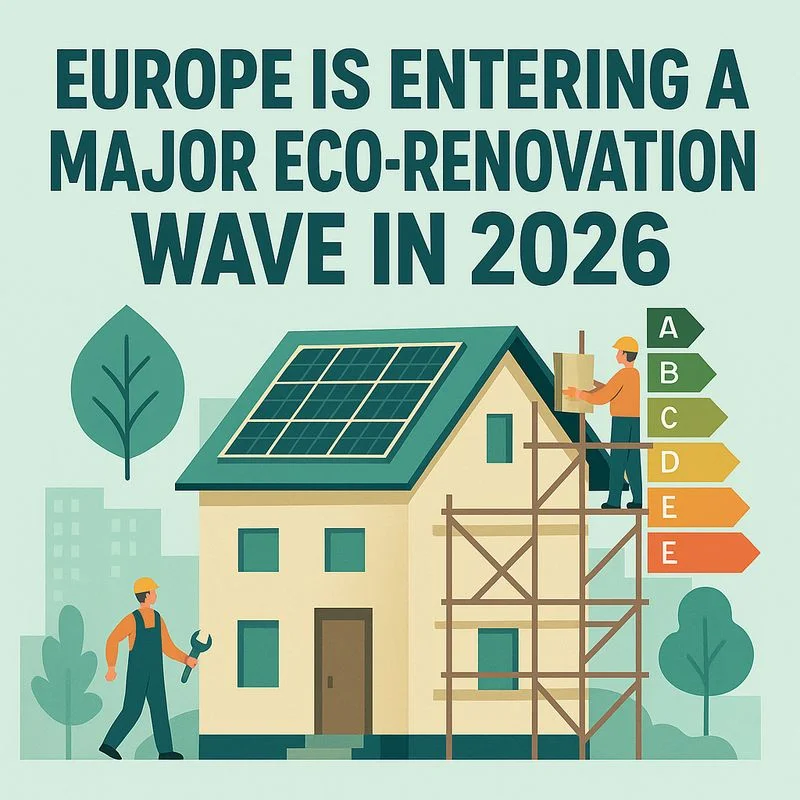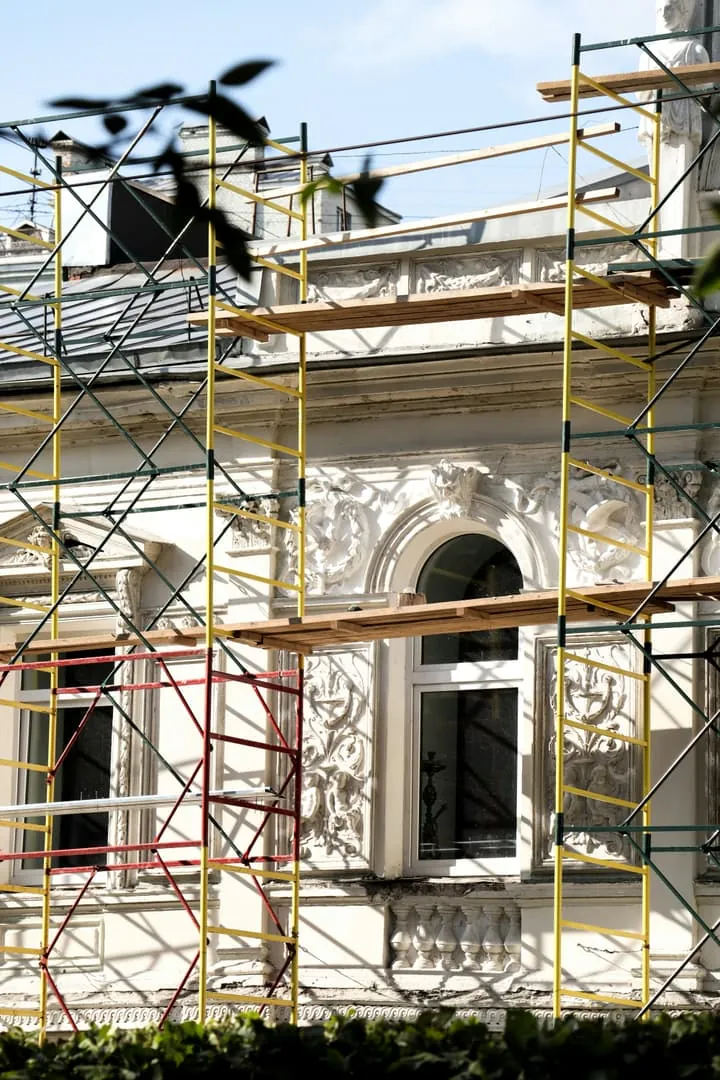
The Great Eco-Upgrade Wave of 2026: What Homeowners Must Do Before Renovation Costs Surge
2026 will mark a historic turning point for homes across Europe. With the updated EPBD directive, millions of homeowners will soon be required to undertake major energy renovations to meet new climate standards. But behind these obligations lies a rare opportunity: being among the first to benefit from reinforced financial aid, a still-accessible market, and available certified installers. One thing is certain: as 2026 approaches, prices will rise, contractor schedules will fill up, and competition for certified professionals will intensify. By planning early, homeowners can save thousands, improve winter comfort, and significantly increase the long-term value of their property.
1) The European shift: what EPBD changes in 2026
The revised EPBD directive in 2025 reshapes the energy renovation landscape across the European Union. Its goal is clear: sharply cut emissions from buildings, which account for around 36 % of final energy use in Europe.
Key measures include:
- the gradual phase-out of energy-inefficient homes by 2030;
- the obligation to reach at least class D by 2033;
- the scheduled end of fossil boilers in new installations from 2027 in many countries;
- the systematic integration of smart systems to monitor and control energy use.
This is not a vague recommendation but a binding trajectory for member states. It directly affects millions of homes: an estimated 7 million dwellings in France, 4 million in Germany, and more than 3 million in Spain.
For a longer-term view of where housing is heading, see Future homes France 2030: carbon neutral.
2) Why winter 2025–2026 will reshape the market
Seasonal forecasts from the European Centre for Medium-Range Weather Forecasts point to a colder-than-average winter with record demand peaks. Combined with energy price volatility, this creates both risk and opportunity.
Analysts expect:
- demand for insulation up by around 28 %;
- heat pump demand up by roughly 18 %;
- residential solar installations up by 40 %;
- smart heating control systems up by 60 %.
The challenge: manufacturers and installers will not be able to serve everyone at once, and certified contractors are already in high demand. Acting during winter 2025–2026 helps you avoid:
- installation lead times stretching to 4–7 months;
- price increases estimated at 12–20 % in 2026;
- shortages of key materials such as wood fiber insulation or micro-inverters;
- difficulty securing an available certified installer.
To prepare your home for this pivotal winter, also explore Winter 2025: Stay warm, waste less and Winter 2025: how to cut your electricity bill without losing comfort.
3) The most profitable renovations for 2025–2026
Not all works deliver the same impact on your energy bill or property value. Experts highlight a core set of priority upgrades for 2025–2026.
- Roof insulation — the strongest thermal ROI
Up to 30 % of a home's heat loss occurs through the roof. High-performance attic or roof insulation is often the first recommendation in energy audits. Typical annual savings: €450–€850. Average payback: 3–5 years.
- Hybrid heat pump — the most versatile solution
Hybrid heat pumps combine a heat pump with an existing gas or oil boiler and select the most efficient source depending on weather and kWh price. Annual savings: €600–€1,800. Payback: 5–7 years.
- Solar plus battery kit — fast-track self-consumption
With reforms expected in 2026, self-production becomes even more profitable when you can store part of the energy in a home battery. Estimated payback: 6–8 years (vs 11–12 years in 2023).
- Airtightness and double-flow ventilation — instant comfort gains
By reducing uncontrolled drafts while renewing air through mechanical ventilation with heat recovery, you boost comfort, health, and efficiency at once. Payback: 4–6 years.
- Smart thermostats — quick, low-cost savings
Smart thermostats and smart valves adapt temperature to your schedule, weather, and off-peak hours. Payback: 1–2 years. Typical impact: 12–18 % reduction in heating bills.
For deeper dives into these technologies, see Eco heating 2026: the sustainable trends to watch and Smart thermostats 2025 France.
4) Subsidies and financing that will intensify in 2026
2026 is shaping up to be a record year for public support to whole-house renovation. Several EU countries are strengthening their schemes:
- France: larger grants for global renovations, extended MaPrimeRénov', and eco-loans up to €50 000;
- Germany: super-bonuses for heat pumps and deep retrofits;
- Italy: revised eco-deductions;
- Spain: enhanced credits for insulation and solar self-consumption.
A key trend: whole-house retrofits (insulation + heating + ventilation) receive significantly higher subsidies — sometimes up to 30 % more than isolated works.
In France, the winning combination increasingly includes MaPrimeRénov', CEE bonuses, local grants, the state eco-loan, and bank green loans. For a detailed walkthrough, refer to France's green home loans 2025: how to finance your eco-renovation.
5) Costly pitfalls to avoid
Even with stronger subsidies, certain missteps can be expensive:
- Choosing a non-certified installer → partial or total loss of public grants.
- Signing quotes or starting work before your applications are approved → automatic rejection of several programs.
- Multiplying small, uncoordinated upgrades → disappointing results and loss of performance bonuses.
- Skipping the energy audit → inconsistent technical choices, oversizing, and wasted money.
- Forgetting regular maintenance of key systems (heat pumps, ventilation units, boilers) → loss of efficiency and increased breakdown risk in winter.
To steer clear of these issues, rely on public platforms such as France Rénov and comparison tools like Hello Watt or Effy.
6) Recommended strategy before February 2026
For homeowners who want to stay ahead of the 2026 wave, a simple roadmap can make all the difference:
- Start with a certified energy audit.
- Prioritise insulation (roof, walls, windows) before changing the heating system.
- Request two or three quotes from RGE-certified professionals.
- Submit financial aid applications before 2026 rule changes take effect.
- Use green loans with low interest rates to finance the remaining balance.
- Schedule major works outside peak pressure periods (summer or early autumn).
This structured approach tends to deliver the best 10–15 year returns, as shown in our guides Heat pump or full eco-renovation: what should you choose in 2025? and Passive homes: when technology makes sustainability comfortable.
7) Case study: a family saving €850 per year
Consider a family living in a 1980s house in Burgundy. In 2025, they carried out three key upgrades:
- full roof insulation with wood fiber;
- installation of a hybrid heat pump;
- room-by-room smart thermostat control.
Total investment: €23 000. Grants received: €12 500 (MaPrimeRénov', CEE, regional support). Estimated annual savings: around €850 on energy bills. Estimated property value increase: +12 %.
This kind of scenario is increasingly common in case studies shared by France Rénov and ADEME. It shows the benefits of combining insulation, efficient equipment, and smart control instead of relying on a single isolated measure.
Frequently Asked Questions
How can I plan works ahead of 2026?
Start with an energy audit, then build a multi-step renovation plan prioritising insulation and filing aid applications as early as possible.
Which renovation delivers the best return on investment?
In most cases, roof insulation and then wall insulation top the list, especially when paired with an efficient heating system.
Can eco-loans and MaPrimeRénov' be combined in 2026?
Yes — provided you meet income and technical criteria, it is possible to combine zero-interest eco-loans with MaPrimeRénov' grants. For more details, see France's green home loans 2025: how to finance your eco-renovation.
Conclusion: The 2026 renovation wave is not a threat but a unique chance to cut bills, improve comfort, and get ahead of regulations that will eventually become unavoidable. Homeowners who plan, get informed, and act during winter 2025 will save the most while boosting the long-term value of their home. The energy transition starts at home — and now is the right time to prepare.
About the author:
Alexandre Dubois is a French sustainability enthusiast sharing practical tips for greener living. With years of experience in energy efficiency consulting, he helps households reduce their environmental impact without sacrificing comfort. Contact: info@greendailyfix.com
Related posts

Winter 2025: Stay Warm, Waste Less
Winter is here, and with it the temptation to crank up the thermostat. But comfort does not have to mean waste. Here are ten simple, natural, and effective ways to stay warm while saving energy and caring for the planet.

Eco Heating 2026: The Sustainable Trends to Watch Now
Winter 2025–2026 marks a key turning point. With fluctuating energy prices, French households are turning toward greener, more stable, and local heating solutions. In 2026, three major trends stand out: hybrid heat pumps, domestic biogas, and smart thermal storage. Here's how they're reshaping the way we heat our homes sustainably.

Heat Pump or Full Eco-Renovation: What Should You Choose in 2025?
With rising energy costs and growing environmental pressure, more French homeowners are asking: Should I install a heat pump or go for a full eco-renovation? In 2025, both paths receive strong subsidies — yet their goals, timelines, and returns differ. Here's the complete guide to understanding, comparing, and choosing the best long-term investment for your home.

Green Insulation 2025: The Hidden Power of Eco-Friendly Materials
Insulation is the invisible core of every successful renovation. In 2025, eco-friendly materials — hemp, wood fiber, cork, cellulose — are moving from niche to norm. They combine thermal efficiency, comfort, and low carbon impact. Here’s how natural insulation is reshaping homes and energy bills.